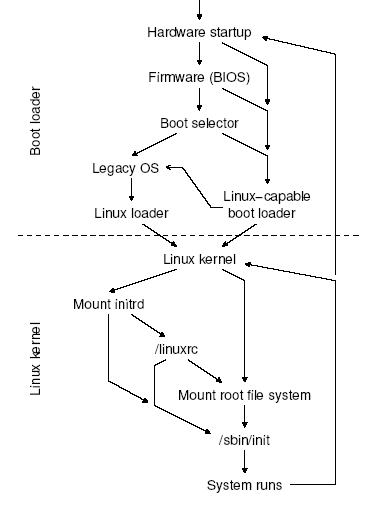Abstract:
Booting an operating system has always been considered a challenging task. In this document we will take a look at the different aspects of the boot process. Such as the BIOS which is the first code which runs, the boot loaders that can load different operating systems, pass arguments to the kernel, load it from different sources like a hard drive, a flash, and network & finally the kernel itself. Though loading the kernel & setting it up to execute is not all that is to be done, we need to bring the system up with different user specific configurations. We will look at the scripts, which deal with this.
Linux has grown from a system that used to boot from a floppy providing no luxurious features to the user, to the current jazzy Linux systems. It is important to have an insight of the Linux boot procedure. Say for Linux to serve the purpose on embedded systems, the generic boot procedure must almost always be modified to meet the needs of the target application. Introduction:The moment after a computer is powered on, the systems memory is empty, the processor has no clue as to where it is & what it is supposed to execute. To see us through this situation a special hardware circuit raises the logical value of the RESET pin of the CPU. After RESET is thus asserted, some registers of the processor are set to fixed values, and the code found at physical address 0xFFFF FFF0, which is system BIOS, is executed. The BIOS does the POST ,some initialization & loads the boot sector from the boot device. The code that sits in the MBR is the boot loader; it gives us the ability to load multiple operating systems. The next in this process is the kernel itself, but its not as straight as it looks there are a few critical steps, which we will see in details a bit later. After the kernel is up and running it needs to mount the root file system. Say if the file system driver compiled as module then we won’t be able to directly mount the real root file system. To get over this we use an initrd images, which has the modules & a “linuxrc “ which can be a script or a binary. This will mount the real root file system & run init process. The init process reads the scripts & starts all the services according to the configuration. This is the final step in the boot process, now our system is all set to go..
Read more: Milind Arun Choudhary
Booting an operating system has always been considered a challenging task. In this document we will take a look at the different aspects of the boot process. Such as the BIOS which is the first code which runs, the boot loaders that can load different operating systems, pass arguments to the kernel, load it from different sources like a hard drive, a flash, and network & finally the kernel itself. Though loading the kernel & setting it up to execute is not all that is to be done, we need to bring the system up with different user specific configurations. We will look at the scripts, which deal with this.
Linux has grown from a system that used to boot from a floppy providing no luxurious features to the user, to the current jazzy Linux systems. It is important to have an insight of the Linux boot procedure. Say for Linux to serve the purpose on embedded systems, the generic boot procedure must almost always be modified to meet the needs of the target application. Introduction:The moment after a computer is powered on, the systems memory is empty, the processor has no clue as to where it is & what it is supposed to execute. To see us through this situation a special hardware circuit raises the logical value of the RESET pin of the CPU. After RESET is thus asserted, some registers of the processor are set to fixed values, and the code found at physical address 0xFFFF FFF0, which is system BIOS, is executed. The BIOS does the POST ,some initialization & loads the boot sector from the boot device. The code that sits in the MBR is the boot loader; it gives us the ability to load multiple operating systems. The next in this process is the kernel itself, but its not as straight as it looks there are a few critical steps, which we will see in details a bit later. After the kernel is up and running it needs to mount the root file system. Say if the file system driver compiled as module then we won’t be able to directly mount the real root file system. To get over this we use an initrd images, which has the modules & a “linuxrc “ which can be a script or a binary. This will mount the real root file system & run init process. The init process reads the scripts & starts all the services according to the configuration. This is the final step in the boot process, now our system is all set to go..

Read more: Milind Arun Choudhary



0 comments:
Post a Comment